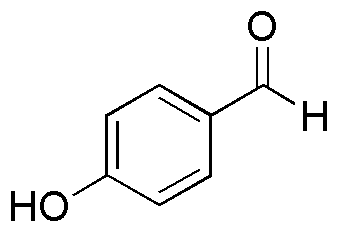4-Hydroxybenzaldehyde is widely utilized in research focused on:
- Pharmaceutical Development: This compound serves as a key intermediate in the synthesis of various pharmaceuticals, including anti-inflammatory and analgesic drugs, enhancing their efficacy and safety profiles.
- Fragrance Industry: It is used in the formulation of perfumes and fragrances, providing a pleasant floral scent that is both appealing and versatile for cosmetic products.
- Analytical Chemistry: 4-Hydroxybenzaldehyde acts as a reagent in analytical methods, such as spectrophotometry, helping researchers identify and quantify other compounds effectively.
- Polymer Chemistry: This chemical is incorporated into polymer formulations to improve thermal stability and mechanical properties, making it valuable in the production of durable materials.
- Food Industry: It is utilized as a flavoring agent and preservative, contributing to the sensory qualities of food products while also extending shelf life.
General Information
Properties
Safety and Regulations
Applications
4-Hydroxybenzaldehyde is widely utilized in research focused on:
- Pharmaceutical Development: This compound serves as a key intermediate in the synthesis of various pharmaceuticals, including anti-inflammatory and analgesic drugs, enhancing their efficacy and safety profiles.
- Fragrance Industry: It is used in the formulation of perfumes and fragrances, providing a pleasant floral scent that is both appealing and versatile for cosmetic products.
- Analytical Chemistry: 4-Hydroxybenzaldehyde acts as a reagent in analytical methods, such as spectrophotometry, helping researchers identify and quantify other compounds effectively.
- Polymer Chemistry: This chemical is incorporated into polymer formulations to improve thermal stability and mechanical properties, making it valuable in the production of durable materials.
- Food Industry: It is utilized as a flavoring agent and preservative, contributing to the sensory qualities of food products while also extending shelf life.
Documents
Safety Data Sheets (SDS)
The SDS provides comprehensive safety information on handling, storage, and disposal of the product.
Product Specification (PS)
The PS provides a comprehensive breakdown of the product’s properties, including chemical composition, physical state, purity, and storage requirements. It also details acceptable quality ranges and the product's intended applications.
Certificates of Analysis (COA)
Search for Certificates of Analysis (COA) by entering the products Lot Number. Lot and Batch Numbers can be found on a product’s label following the words ‘Lot’ or ‘Batch’.
*Catalog Number
*Lot Number
Certificates Of Origin (COO)
This COO confirms the country where the product was manufactured, and also details the materials and components used in it and whether it is derived from natural, synthetic, or other specific sources. This certificate may be required for customs, trade, and regulatory compliance.
*Catalog Number
*Lot Number
Safety Data Sheets (SDS)
The SDS provides comprehensive safety information on handling, storage, and disposal of the product.
DownloadProduct Specification (PS)
The PS provides a comprehensive breakdown of the product’s properties, including chemical composition, physical state, purity, and storage requirements. It also details acceptable quality ranges and the product's intended applications.
DownloadCertificates of Analysis (COA)
Search for Certificates of Analysis (COA) by entering the products Lot Number. Lot and Batch Numbers can be found on a product’s label following the words ‘Lot’ or ‘Batch’.
*Catalog Number
*Lot Number
Certificates Of Origin (COO)
This COO confirms the country where the product was manufactured, and also details the materials and components used in it and whether it is derived from natural, synthetic, or other specific sources. This certificate may be required for customs, trade, and regulatory compliance.


